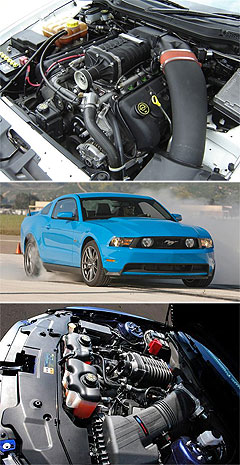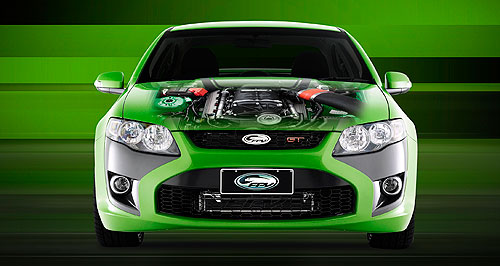Future models - FPV - GTFPV to reveal blown V8 next weekBlown away: FPV's new supercharged Coyote V8 will be revealed next week. Ford US reveals 465kW supercharged Coyote a week before FPV’s blown V8 emerges23 Aug 2010 FORD Performance Vehicles is less than a week away from revealing the bristling new supercharged ‘Coyote’ V8 that will power its 2010 Falcon-based line-up from October, but don’t expect it to match the stratospheric 465kW peak output Ford Racing engineers have just extracted from the same new 5.0-litre V8 in the US – at least not yet. As we’ve reported, FPV will present its 2010 V8 model line-up at the Bathurst 1000 over October 7-10, before it makes its motor show debut in Sydney the following Friday (October 15) and hits Ford dealerships around Australia soon after. Before then, however, FPV will officially take the wraps of the locally developed version of Ford’s all-new 5.0-litre alloy V8 in Melbourne next Monday (August 30), little more than a week after Ford Racing announced three ballistic new – but completely unrelated – aftermarket supercharger kits for the new all-alloy V8 in North America. GoAuto understands the announcement of the Ford Motor Company’s own (albeit retro-fit) Coyote blower kit comes as a surprise even to FPV, whose parent company Prodrive has spent the past three years developing its own high-performance engine after dismissing other potential options, including Jaguar’s latest force-fed 5.0-litre V8, on the basis of cost.  From top: Harrop supercharged Ford Falcon XR8 5.4 Boss, Ford Mustang GT and Ford Mustang GT supercharger. From top: Harrop supercharged Ford Falcon XR8 5.4 Boss, Ford Mustang GT and Ford Mustang GT supercharger.The result is a homegrown supercharger housing – developed by Harrop Engineering – that will contain Eaton rotors. As the master distributor for Eaton across the Asia Pacific region, Harrop also supplies Walkinshaw Performance, which is owned by Tom Walkinshaw - who also owns FPV arch-rival Holden Special Vehicles. Using Harrop-supplied components, WP offers a range of blower kits for Holden’s 6.0-litre V8 and HSV’s 6.2-litre (LS3) and discontinued 6.0-litre (LS2) V8s, while Harrop itself offers a self-branded supercharger kit for Ford’s outgoing 5.4-litre Boss V8. Fitted with a Harrop Stealth HTV2300 supercharger assembly containing Eaton TVS rotors, the BA-BF Falcon V8 slams down about 350kW at the rear wheels, while the HSV GTS-based Vauxhall VXR8 Bathurst S sold in the UK since last year runs a Stage 2 WP supercharger kit that develops 420kW/715Nm and is priced from about $15,000, and also comes with a 12-month/20,000km warranty. Earlier this year, WP also released the Holden Commodore SS-V Sportwagon Special Edition-based ‘WP Superwagon’, which mustered up no less than 450kW and 770Nm from its WP190 Supercharger-equipped 6.0-litre Gen IV V8, as well as an ‘E2 Supercar’ kit for the 6.2 LS3 V8 that cranked out a space shuttle-like 480kW and 802Nm. Over at FoMoCo, the Ford Racing supercharger kits represent the first power upgrade for the new 32-valve TiVCT Ford V8, which debuted in the 2011 Mustang GT and delivers as much as 328kW in the naturally aspirated 2012 Mustang Boss also announced in the US on Friday. Ford Racing claims its first twin-screw Mustang supercharger – developed in conjunction with Roush and Whipple and street-legal in all 50 US states – develops a staggering 525hp (392kW) at 6400rpm and no less than 470lb-ft (637Nm) of torque from 4200rpm at just 7psi of boost on 93-octane fuel. Even more astonishingly, Ford Racing’s more powerful (but still US road-legal) blower kit extracts a V8 Supercar-like 624hp (465kW) at 6900rpm and 536lb-ft (727Nm) at 4700rpm from the 5.0-litre Coyote V8 when running 9psi of boost. While the latter is not offered with the same 12-month/12,000-mile warranty Ford Racing provides with the entry-level kit, no performance outputs are specified for a third, racetrack-only supercharger kit. For the record, Ford Racing’s Coyote blower kits, which were subjected to more than 100 hours of accelerated durability testing, include a 2.3-litre twin-screw supercharger assembly, a new intake manifold, complete air-to-liquid intercooler system, drive belt, high-impedance fuel injectors and a Ford Racing ProCal tool with performance calibration. The street-legal Ford Racing kit for the 5.0-litre Coyote V8, which is already available in crate form in the US, is now on sale in North America, priced from $US7199 ($A8070) in black paint or $US7799 ($A8745) in polished chrome, or just $US6499 ($A7286) for the track-only kit. Of course, official details for FPV’s homegrown supercharged Coyote V8 won’t be announced until next week, but given the surprising results achieved for the same engine by Ford Racing in the US, the 300kW-plus outputs widely rumoured for FPV’s 2010 V8 range could well prove to be pessimistic. As we’ve reported, GoAuto has sighted official federal regulatory documents that state Ford’s own XR8 will employs a supercharged 5.0-litre V8 delivering 315kW – up 25kW on the 290kWon tap from the outgoing XR8’s cast-iron SOHC 5.4-litre Boss V8. Peak torque should also increase from 520 to about 550Nm. The next XR8 should therefore improve upon the standard 307kW/529Nm Coyote V8’s output by just 8kW but, more importantly, will easily out-muscle the 270kW/530Nm peak on offer from the 6.0-litre V8 in Holden’s Commodore SS, the XR8’s most direct rival. It should also be the most modest of three versions of the blown Coyote to become available, however, with our sources maintaining that FPV’s mainstream V8 will offer 335kW/600Nm – well up on the outgoing FPV GT’s 315kW/551Nm outputs and easily shading HSV’s mainstream 317kW/550Nm LS3, which delivers 325kW in the GTS flagship. Outputs of about 400kW and 650Nm from next year’s range-topping FPV GT-HO now appear to be easily achievable, given Ford Racing’s most basic Coyote-Mustang supercharger kit churns out almost that much performance running on 93-octane petrol with just 7psi of boost. “Superchargers are the ultimate in power upgrades for Mustang enthusiasts.” said Ford Racing performance group manager George Goddu in a press release issued on the eve of the Mustang supercharger package’s reveal at the Ford Mustang Alley display as part of the annual Woodward Dream Cruise event in the US on Saturday. “Calibration for a modern V8 engine, especially one with twin-independent variable cam timing, is incredibly complex. Production calibration for the 5.0 engine took 19 months. Having that knowledge base to work from is a huge advantage. “In fact we had the whole engineering background of the engine right from initial concept. With that knowledge base, and extensive collaboration across the team, we are able to offer a top-notch supercharger, induction kit and the optimum calibration. This results in great power, drivability and durability.”  Read moreAll future models Alfa Romeo Alfa Romeo Abarth Abarth Audi Audi Aston Martin Aston Martin BMW BMW Bentley Bentley Chrysler Chrysler Chevrolet Chevrolet Dodge Dodge Citroen Citroen Ferrari Ferrari DS DS Ford Ford Fiat Fiat FPV FPV Foton Foton Haval Haval Great Wall Great Wall Honda Honda Holden Holden Hyundai Hyundai HSV HSV Isuzu Isuzu Infiniti Infiniti Jeep Jeep Jaguar Jaguar Lamborghini Lamborghini Kia Kia Lexus Lexus Land Rover Land Rover Mazda Mazda Maserati Maserati Mercedes-Benz Mercedes-Benz McLaren McLaren Mini Mini Nissan Nissan Mitsubishi Mitsubishi Peugeot Peugeot Opel Opel Proton Proton Porsche Porsche Renault Renault Ram Ram Saab Saab Rolls-Royce Rolls-Royce Smart Smart Skoda Skoda Subaru Subaru SsangYong SsangYong Tesla Tesla Suzuki Suzuki Toyota Toyota Volvo VolvoMotor industry news |
Click to shareFPV modelsAll future models Alfa Romeo Alfa Romeo Abarth Abarth Audi Audi Aston Martin Aston Martin BMW BMW Bentley Bentley Chrysler Chrysler Chevrolet Chevrolet Dodge Dodge Citroen Citroen Ferrari Ferrari DS DS Ford Ford Fiat Fiat FPV FPV Foton Foton Haval Haval Great Wall Great Wall Honda Honda Holden Holden Hyundai Hyundai HSV HSV Isuzu Isuzu Infiniti Infiniti Jeep Jeep Jaguar Jaguar Lamborghini Lamborghini Kia Kia Lexus Lexus Land Rover Land Rover Mazda Mazda Maserati Maserati Mercedes-Benz Mercedes-Benz McLaren McLaren Mini Mini Nissan Nissan Mitsubishi Mitsubishi Peugeot Peugeot Opel Opel Proton Proton Porsche Porsche Renault Renault Ram Ram Saab Saab Rolls-Royce Rolls-Royce Smart Smart Skoda Skoda Subaru Subaru SsangYong SsangYong Tesla Tesla Suzuki Suzuki Toyota Toyota Volvo VolvoMotor industry news |
















Facebook Twitter Instagram